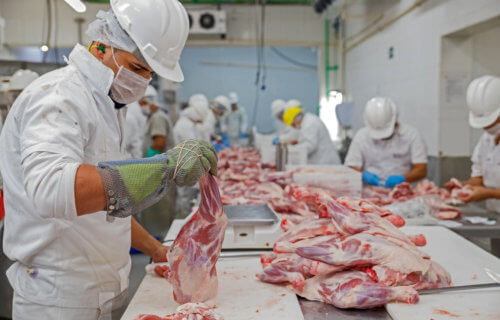DAVIS, Calif. — Over 31 million people across America has tested positive for COVID-19, roughly one-tenth of the population. While there are several factors which make certain residents more susceptible to infection, a new report says factories in your area may play a role as well. Researchers in California contend having large meatpacking plants around communities lead to higher transmission rates and billions in economic damage.
A team from the University of California-Davis estimates that 334,000 COVID-19 cases are due to exposure to meatpacking plants. Their research reveals U.S. counties with beef and pork-processing plants have per capita infection rates which are more than double the average during the pandemic. Counties with chicken-processing plants had virus transmission rates 20 percent higher than the norm.
Study authors specifically looked at meatpacking plants producing more than 10 million pounds of food per month. Along with a 160-percent increase in the infection rate around pork plants, researchers calculate the economic fallout of deaths, health care costs, and lost wages totals around $11.2 billion.
The team studied COVID infection rates within counties, noting they did not account for cases contracted in a meatpacking plant and then spread to others in surrounding counties. With this in mind, researchers call their estimates “conservative.”
In the same vein, the study examined lost wages and death rates connected to the meatpacking industry. However, the report did not include long-term health care costs and the costs tied to improving worker safety during COVID.
“While we did see an initial ramp up in cases attributable to meatpacking facilities, over time infection rates were the same per capita as counties without them, partly because meatpacking plants implemented a lot of protocols to protect employees,” says lead author Tina Saitone, a livestock and rangeland economics cooperative extension specialist, in university release.
What drives the spread of COVID-19?
Saitone admits there are many factors which drive up the likelihood of contracting COVID at the county level. The UC-Davis team tried to account for several, including the number of local nursing homes and correctional facilities in an area. The study also considered stay-at-home orders, local safety mandates, population density, demographics, economic factors, and the general health of residents — all which can raise or lower the spread of coronavirus. Their estimates focused on infections coming within 150 days of the first reported case of COVID in each county.
With meatpacking plants possibly contributing to the pandemic, some critics are calling for the industry to convert to smaller and more spread-out facilities. Researchers say this may make it harder for pandemics to disrupt the national food supply in the future.
Unfortunately, the study also notes this would come at a tremendous cost; adding expenses which large factories can eliminate and therefore driving up the cost of food. Instead, some economists believe turning to automation will be the key to making meat production safer. Study authors note that technological innovations in the poultry industry are one reason their virus rates are lower than other meat producers during the pandemic.
The study appears in the journal Food Policy.
